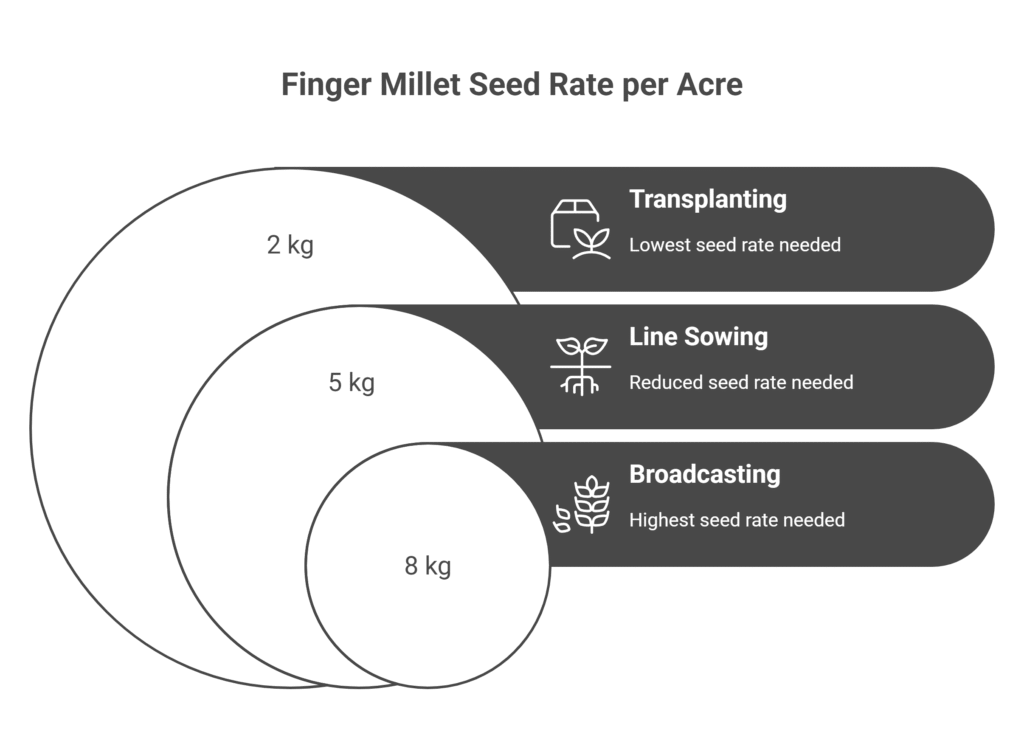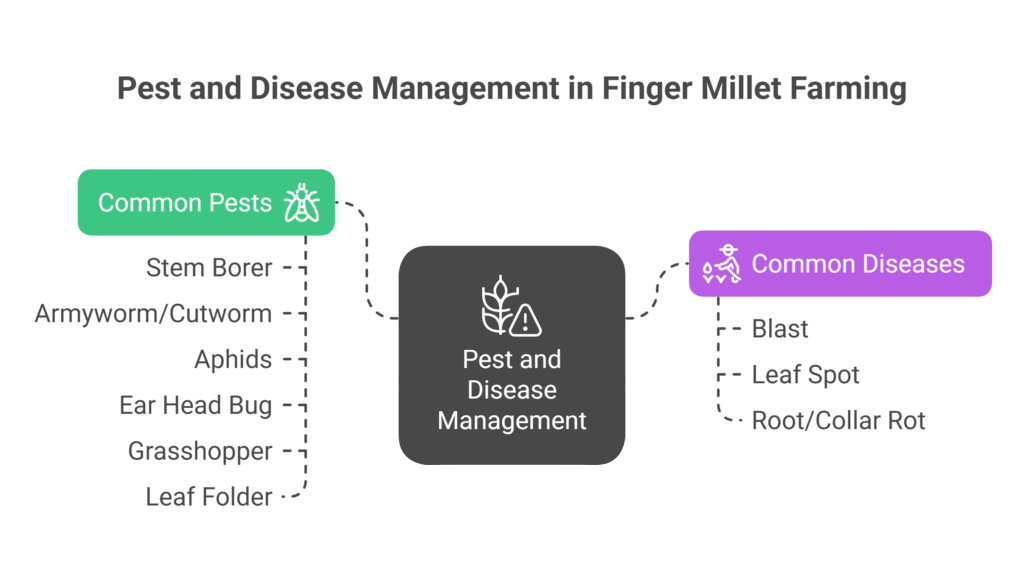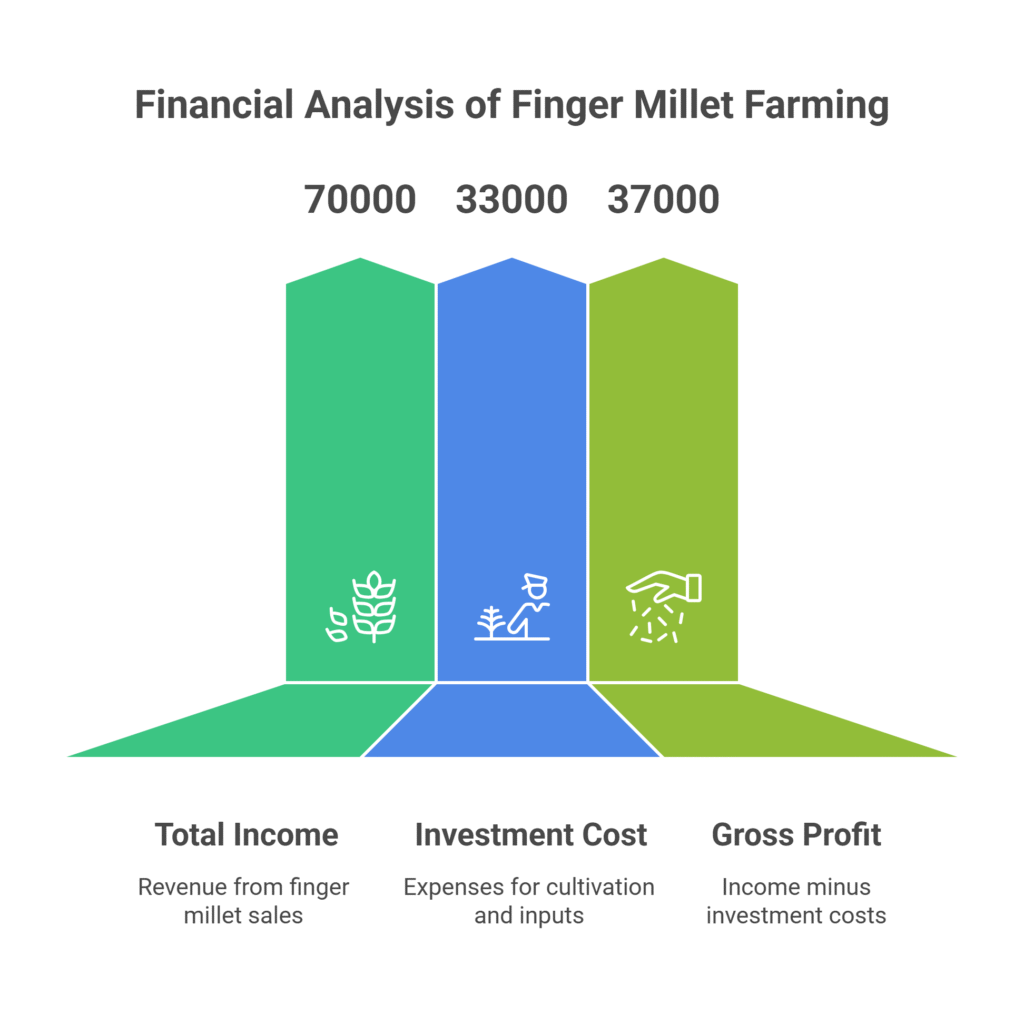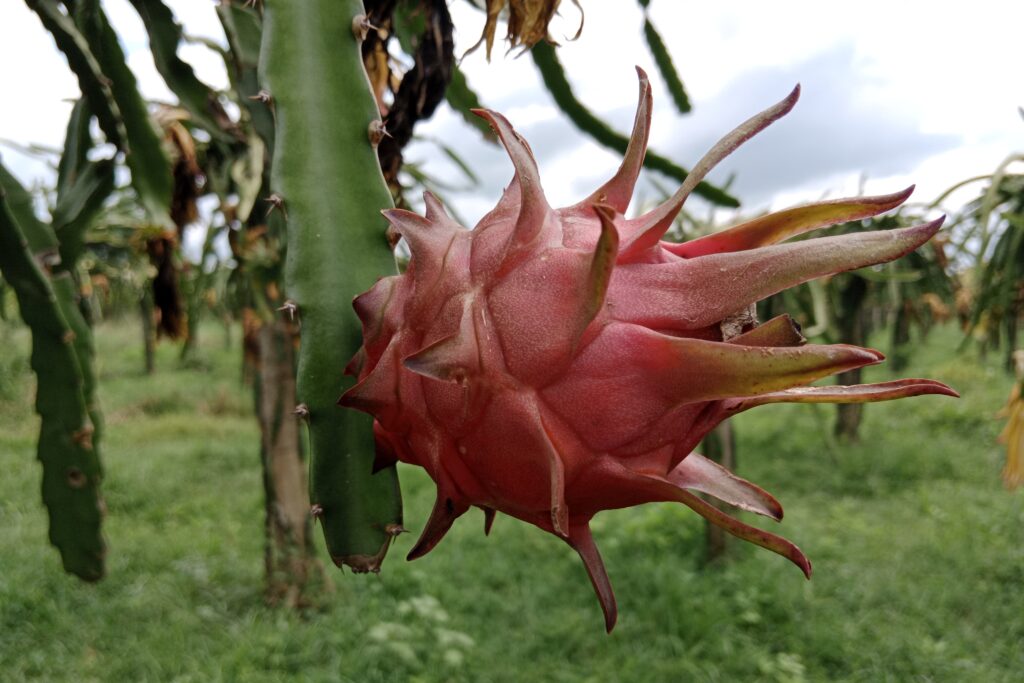Finger Millet Farming
Finger millet (Eleusine coracana), commonly known as Ragi, is a highly nutritious, drought-tolerant cereal crop vital for food security in semi-arid regions. Finger millet farming profit per acre can be evaluated through a basic profit analysis that highlights its economic viability. With a total income of NRs. 70,000 and an investment cost of NRs. 33,000, the gross profit amounts to NRs. 37,000. This results in a profit margin of 52.86% and a benefit-cost ratio (BCR) of 2.12, indicating that every rupee invested yields a return of NRs. 2.12, making finger millet cultivation a profitable venture under proper management.
Land Preparation
Land preparation begins with deep ploughing to a depth of 15–20 cm immediately after the harvest of the previous crop or with the onset of rains, which helps expose soil pests and uproot weeds. This is followed by 2–3 rounds of harrowing to break soil clods, incorporate crop residues or weeds, and level the field. The goal is to achieve a fine, loose tilth that is ideal for sowing small seeds, while also ensuring the field has proper drainage to avoid waterlogging. These operations can be performed manually using tools like spades and hoes or mechanically with tractor-drawn implements.
Soil Type
Finger millet thrives best in well-drained loamy to sandy loam soils, demonstrating considerable tolerance by growing successfully across a wide range of soil types, including red laterite and black soils, as well as moderately alkaline soils; however, it is crucial to avoid heavy clay soils prone to waterlogging, highly saline or sodic soils, and extremely gravelly or rocky soils, with the ideal soil pH range for optimal growth being moderately acidic to moderately alkaline (5.0 – 8.0).
Climatic Requirements
| Climatic Parameter | Requirement | Notes |
| Temperature | Warm-season crop. Optimum range: 20°C to 30°C. | · Germination requires a minimum. soil temp ~8-10°C. · Sensitive to frost at all growth stages. |
| Rainfall | Ideal: 500 mm to 1000 mm annually. | · Tolerant of drought stress, especially post-establishment (suitable for rainfed). · Requires even distribution during vegetative growth & flowering. · Needs dry weather during grain filling & ripening. |
| Altitude | Grown from sea level up to 2400 meters. | · Especially common in the hilly regions and East African highlands. |
| Light | Requires full sunlight. |
Major Cultivars
Cultivars of finger millet vary significantly across regions, with selection based on factors such as maturity period, yield potential, resistance to diseases like Blast, and local consumer preferences. Below is the list of some major cultivars:
| Variety Series | Varieties | Key Features |
| Indaf Series | Indaf-5, Indaf-7, Indaf-8, Indaf-9 | Early maturing, high yield |
| GPU Series | GPU-28, GPU-45, GPU-48 | Blast resistant |
| VL Series | VL-149, VL-315, VL-324 | Early, drought-tolerant |
| K Series | KAT/FM-1, KAT/FM-4 | High yielding |
| U-15 | U-15 | Popular East African variety |
| Local Landraces | Numerous traditional varieties | Adapted to specific microclimates |
Seed Rate per Acre
The seed rate per acre is influenced by several critical factors such as seed purity and germination percentage, soil fertility, the tillering ability of the selected cultivar, the planting method used, and moisture availability during the growing season. To achieve optimal crop performance, it is recommended to use certified seeds with high genetic and physical purity. The following section outlines various planting methods used for cultivating finger millet.

| Planting Method | Seed Rate per Acre |
| Broadcasting | 8 kg |
| Line Sowing / Drilling | 5 kg |
| Transplanting | 2 kg |
Nursery Management
In regions with adequate moisture, the transplanting method is preferred as it provides higher yields compared to direct seeding and prevents lodging during heavy rains. To raise seedlings for transplanting over one acre, prepare a nursery bed in a well-prepared area of about 200 square meters, enriching the soil with 7–8 baskets of farmyard manure (FYM) along with a small dose of balanced fertilizer to support rapid and healthy seedling growth.
Planting
a) Planting Season
| Season | Sowing Period | Harvesting Period | Key Conditions |
| Kharif/Rainy | June-July (main season) | September-November | Sown with the onset of monsoon |
| Rabi | September-October | January-February | Grown under residual moisture/irrigation in mild winter regions |
| Summer | February-March | May – June | Irrigated crops in suitable areas |
b) Spacing
| Planting Method | Row-to-Row Spacing | Plant-to-Plant Spacing |
| Line Sowing | 30 cm | 8 cm (after thinning) |
| Transplanting | 25 cm | 10 cm |
c) Planting Method
| Sowing Method | Procedure | Key Specifications | |
| Broadcasting | Seeds are scattered uniformly on a prepared seedbed and lightly covered with soil | · Covering method: Planking or harrowing · No row arrangement | |
| Drilling/Line Sowing | Seeds placed in furrows made by drill or seed-cum-fertilizer drill | · Depth: 1-2 cm · Requires row spacing · Equipment: Seed drill used | |
| Transplanting | 1. Nursery preparation: Raise seedlings for 3-4 weeks 2. Pre-pulling: Irrigate the nursery to loosen the soil 3. Root treatment: Dip seedlings in Azospirillum slurry 4. Transplant to the main field | · Seedling age: 3-4 weeks · Biofertilizer: 300g Azospirillum/acre in 40L water · Dip duration: 15-30 minutes · Planting density: 2 seedlings/hill | |
d) Number of Plants per Acre
For optimum yield, aim for 161,880 to 180,000 plants per acre, which can be achieved by maintaining above spacing and performing thinning operations when crops are broadcast or drilled densely.
Intercropping
Intercropping is a common practice in finger millet cultivation to maximize land use and income. Suitable companion crops include pulses like pigeon pea, cowpea, and beans; oilseeds such as groundnut and niger; and vegetables like marigold, which also acts as a pest repellent.
Typically, 2–4 rows of finger millet are alternated with 1–2 rows of the intercrop. This approach offers multiple benefits, including risk diversification, improved soil coverage for weed suppression, nitrogen fixation when legumes are used, enhanced soil health, and higher overall productivity. However, successful intercropping requires careful planning of spacing and nutrient management.
Irrigation
In finger millet farming, irrigation is essential, particularly during crucial growth phases including germination, tillering (20–25 days after sowing), flowering (40–50 DAS), and grain filling. Since the crop is solely dependent on monsoon rainfall under rainfed circumstances, prompt sowing is crucial for its establishment. Four to six irrigations are usually required under irrigated conditions, depending on the type of soil and rainfall patterns. Water stagnation can damage root health, so it is best to use light and frequent irrigations, like furrow irrigation, to maintain proper moisture levels.

Fertilizer and Manure
Finger millet responds well to the application of organic manure, which improves soil health and crop performance. For optimal results, fertilizers should be applied based on the recommendations of a Soil Test Report, ensuring precise nutrient management. In the absence of a soil test, a general fertilizer dose can be followed to support healthy crop growth and yield.
| Application Timing | Material/Type | Recommendation | Application Notes |
| Basal Dose | Farmyard Manure (FYM) / Compost | 4 – 5 tonnes per acre | Incorporated during land preparation |
| (At Planting) | Chemical Fertilizers (NPK) | 40kg N, 20 kg (P₂O₅), 20kg (K₂O) per acre | Apply uniformly before sowing/transplanting |
| Top Dressing | Nitrogen (N) | 20 – 30 kg N per acre | Applied at the active tillering stage (20-30 Days After Sowing/Transplanting – DAS) |
| Zinc Sulphate | 10 – 15 kg per acre | Apply only if zinc deficiency is observed |
Weed Control
Weed control is crucial in finger millet cultivation, particularly during the first 30–45 days after sowing, due to the crop’s slow initial growth. Effective management involves a combination of cultural, mechanical, and chemical methods. Cultural practices include timely sowing, proper seedbed preparation, maintaining optimal plant population, and intercropping to suppress weed growth.
Mechanical control typically involves 2–3 hand weedings or hoeings at intervals of 15–20, 30–35, and, if needed, 45–50 days after sowing, which is especially important for broadcast-sown crops.
Chemical control includes the pre-emergence application of herbicides such as Pendimethalin (1.0–1.5 kg a.i./acre) or Atrazine (0.5–0.75 kg a.i./acre) immediately after sowing. Post-emergence herbicide options are limited, but 2,4-D may be cautiously used to control broadleaf weeds once the crop is well established, avoiding application during the tillering stage. It is essential to follow label instructions strictly to ensure crop safety and herbicide effectiveness.
Flowering and Fruit Management
Flowering in finger millet typically occurs 45–60 days after sowing, with panicles (fingers) emerging from the top of the plant. Effective management during this stage involves maintaining adequate moisture and nutrient levels, as detailed under irrigation and fertilizer practices. There is no specific fruit management such as thinning; instead, the focus shifts to protecting the developing grains through timely pest and disease control measures to ensure healthy grain formation and optimal yield.
Pest and Disease Management

Common Pests
a). Stem Borer
Larvae are typically found in the lower stem region of the plant, where they feed on roots and cause significant damage. In severe infestations, the central shoots dry up and turn yellowish. The larvae are milky white with yellowish heads, while the adult insects are dark brown with white-colored forewings. To control the infestation, spray Carabaryl 50WP at 1 kg per acre or Dimethoate 30 EC at 200 ml in 100 liters of water as soon as symptoms are observed.
b). Armyworm/Cutworm
Armyworms and cutworms typically appear during the early stages of the crop, with caterpillars cutting the base of young plants. These pests are nocturnal, remaining active at night and hiding in soil cracks or under stones during the day, and their infestations tend to be cyclic. To control cutworm eggs, release Trichogramma parasitoids once a week for three consecutive weeks. Upon noticing symptoms, apply Malathion 5% dust at 10 kg per acre or spray Quinalphos 1.5% at 250 ml per acre. After harvesting, it is important to remove weeds and crop stubbles to minimize future infestations.
c) Aphids
Aphids can be observed throughout the growing period, commonly found on the central leaf whorl and ears of the plant. Infestation leads to yellowing of the leaves. The nymphs are round and reddish brown, while the adults are yellow with green legs. To control aphid infestations, spray Methyl Demeton 25EC at 80 ml per acre or Dimethoate 30EC at 200 ml per acre, mixed in 100 liters of water, as soon as the symptoms are noticed.
d) Ear Head Bug
Chaffy grains wrapped in silky webs are the consequence of ear head bugs’ primary attack on the crop during the milky stage, when they feed on emerging panicles. They lay clusters of glossy white eggs with orange hair. Adults have yellowish hind wings and fibrous forewings, while the caterpillars are brown with fine hair and yellow stripes. To control the problem, set up pheromone traps five per acre from blossoming to panicle stage and utilize light traps during the day to draw in adult moths. If the infestation is severe, apply 400 cc of Malathion or 600 g of Carbaryl per 100 liters of water per acre.
e) Grasshopper
Grasshoppers, both nymphs and adults, feed on the leaves of the plant, causing defoliation. Nymphs are whitish with distinct lines on their bodies, while adults are greenish brown with similar markings.
To manage their population, it is essential to maintain field sanitation by removing all plant remains after harvest and practicing proper cleanliness. Summer ploughing after harvest helps expose eggs in the soil to sunlight, destroying them. In dry and moist conditions, the biological control agent Entomophthora grylli can be applied. If infestation is observed, spraying with Carbaryl 50 WP at 600 grams per acre is recommended.
f) Leaf folder
Leaf folder infestation causes the leaves to fold longitudinally, with larvae residing inside and scraping the leaf surface, resulting in visible white patches. A single female can lay around 200 yellowish-white eggs on both sides of the leaf. The larvae are greenish-yellow with brown or black heads, pupae are dark brown and found inside the folded leaves, while adults appear whitish-yellow or golden yellow.
Effective control measures include rotating crops with non-cereals, maintaining field hygiene, avoiding close spacing during sowing, and removing and destroying infested leaves and plant parts away from the field. For chemical control, spray Chlorpyriphos or Quinalphos at 2.5 ml/L, Acephate or Carbaryl at 1 gm/L, or Cartap Hydrochloride at 2 gm/L of water.
Common Diseases
a). Blast (Finger Millet Blast)
Blast disease, common during the Kharif season, can occur at any growth stage and, in severe infestations, gives the crop a blasted or burnt appearance, often leading to lodging. If the disease appears during the nursery stage or at ear development, it can cause significant yield loss.
To manage blast, grow resistant varieties, and perform seed treatment with Carbendazim at 2 gm/kg before sowing. If symptoms appear, immediately spray Carbendazim at 500 gm per acre. Follow up with a second and third spray at 15-day intervals during the flowering stage to control neck and finger infection. Additionally, at 50% earhead emergence, apply a foliar spray of Aureofungin Sol at 100 ppm, followed by a second spray 10 days later with Mancozeb at 400 g per acre or Pseudomonas fluorescens at 0.2% for effective control.
b) Leaf Spot (Helminthosporium)
Leaf spots caused by Helminthosporium appear as brown spots on the leaves, reducing the plant’s photosynthetic efficiency and overall vigor. Effective management includes using disease-resistant varieties, treating seeds with appropriate fungicides before sowing, and applying foliar sprays of Mancozeb at the rate of 2 ml per liter of water when symptoms are observed to control the spread and severity of the disease.
c) Root/Collar Rot
Root or collar rot causes wilting and root decay, and can be managed by avoiding waterlogging, treating seeds before sowing, and drenching the soil with Carbendazim at 2 ml per liter of water.
Harvesting
Depending on the cultivar, finger millet is often harvested 100–120 days after sowing. It is done when the grains harden to the point that a thumbnail cannot easily pierce them, the panicles turn brown, and the straw becomes yellow. Using a sickle or knife, cut the panicles or the entire plant close to ground level to harvest by hand. Small combined harvesters can also be utilized in uniform crop stands. To lower the moisture content before threshing, the plants or panicles are sun-dried on threshing floors for two to four days after harvest.
Yield
The yield of finger millet varies depending on factors such as variety, cultivation practices, and environmental conditions, with an average range of 800 to 1200 kg per acre.
Cost of Investment Per Acre for Finger Millet Farming
| S.N. | Categories | Cost (NRs) |
| 1 | Land Preparation (plowing) | 10,000 |
| 2 | Seed cost | 500 |
| 3 | Nursery Management | 2,000 |
| 4 | Transplanting | 2,000 |
| 5 | Fertilizers and Manure | 4,500 |
| 6 | Irrigation | 3,000 |
| 7 | Weed Control (pre & post-emergence) | 2,000 |
| 8 | Pest & Disease Control | 3,000 |
| 9 | Harvesting | 3,000 |
| 10 | Miscellaneous Costs | 3,000 |
| Total Cost | 33,000 |
Income from per-acre finger millet farming
| Particulars | Estimated Yield (kg) | Market Price (NRs/kg) | Total Income (NRs) |
| Finger Millet Yield | 1,000 | 70 | 70,000 |
Analysis of Finger Millet Farming Profit Per Acre
| Metric | Calculation | Amount (NRs) |
| Total Income | – | 70,000 |
| Total Investment Cost | – | 33,000 |
| Gross Profit | Income – Cost | 37,000 |
| Profit Margin | (Profit ÷ Income) × 100 | 52.86% |
| Benefit-Cost Ratio (BCR) | Income ÷ Cost | 2.12 |
The profit analysis shows a total income of NRs. 70,000 and a total investment cost of NRs. 33,000, resulting in a gross profit of NRs. 37,000. This gives a profit margin of 52.86% and a benefit-cost ratio (BCR) of 2.12, indicating that for every rupee invested, there is a return of NRs. 2.12.
Sources
Indian Institute of Millets Research (IIMR)
Nepal Agricultural Research Council (NARC)
Dida, M.M., & Devos, K.M. (2006). Finger Millet: Eleusine coracana. In Cereals and Millets. Springer.



